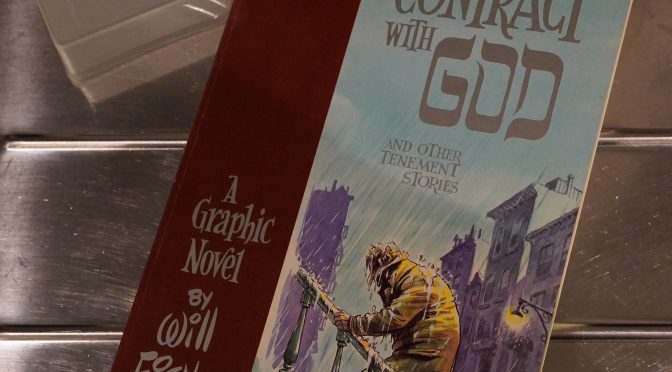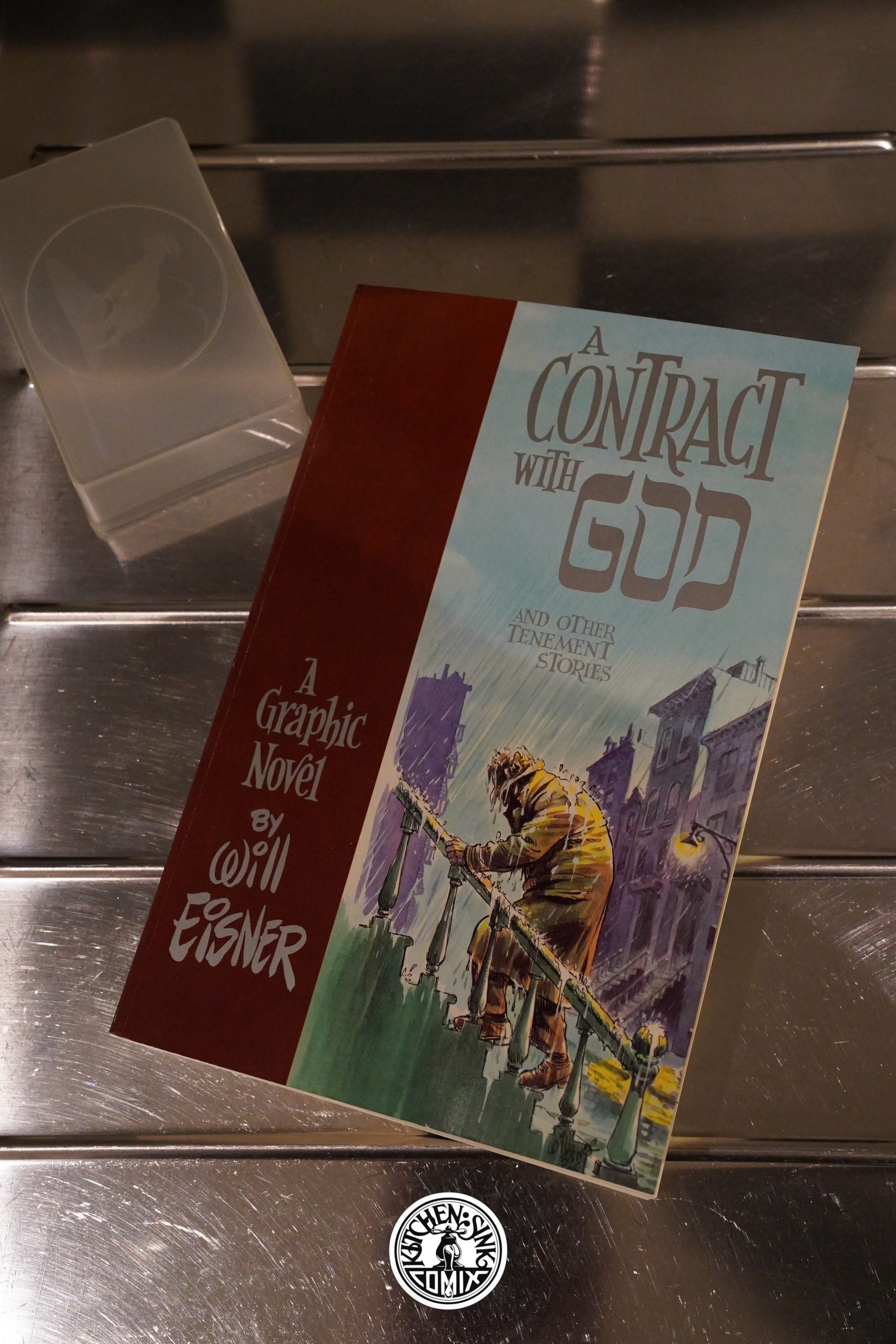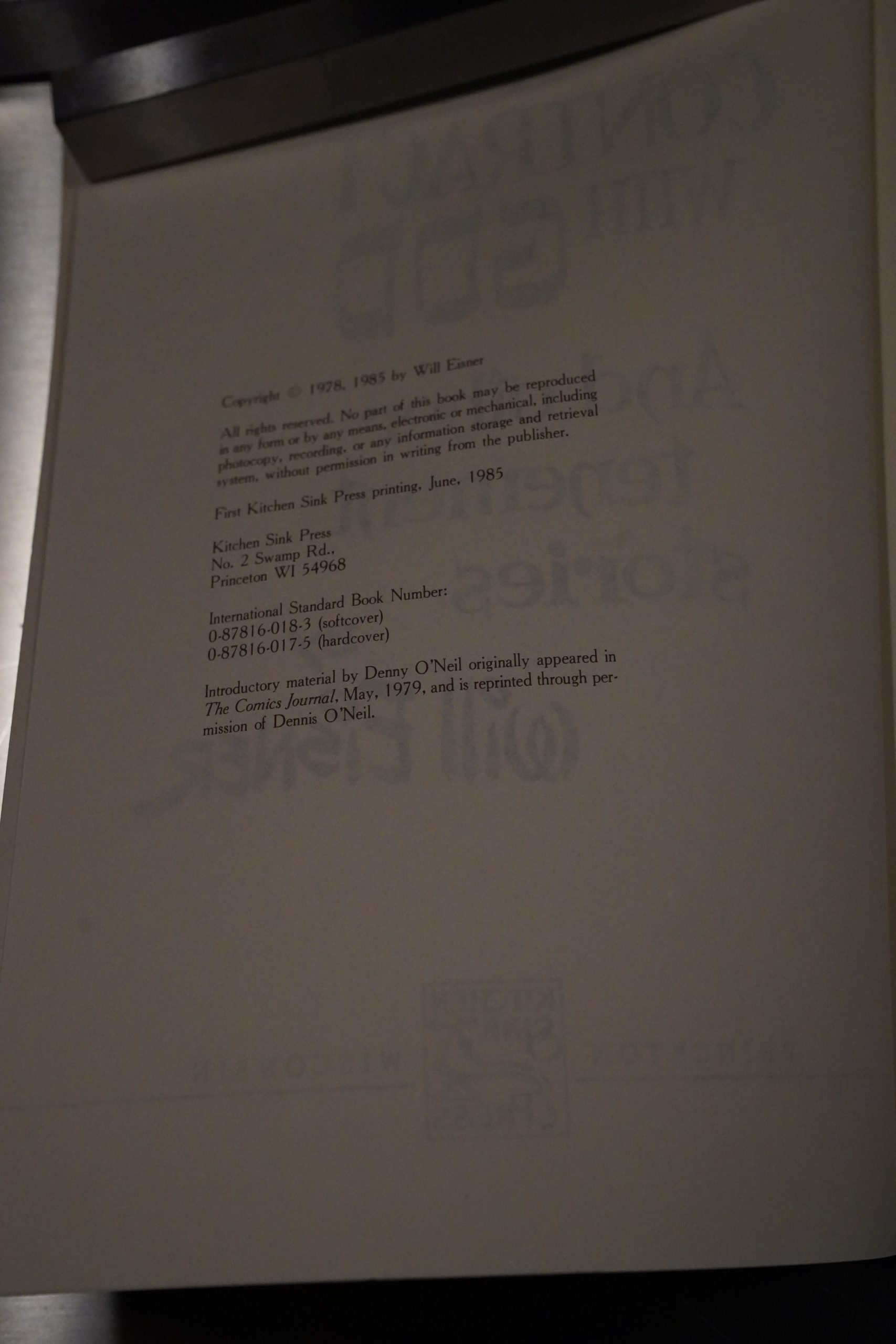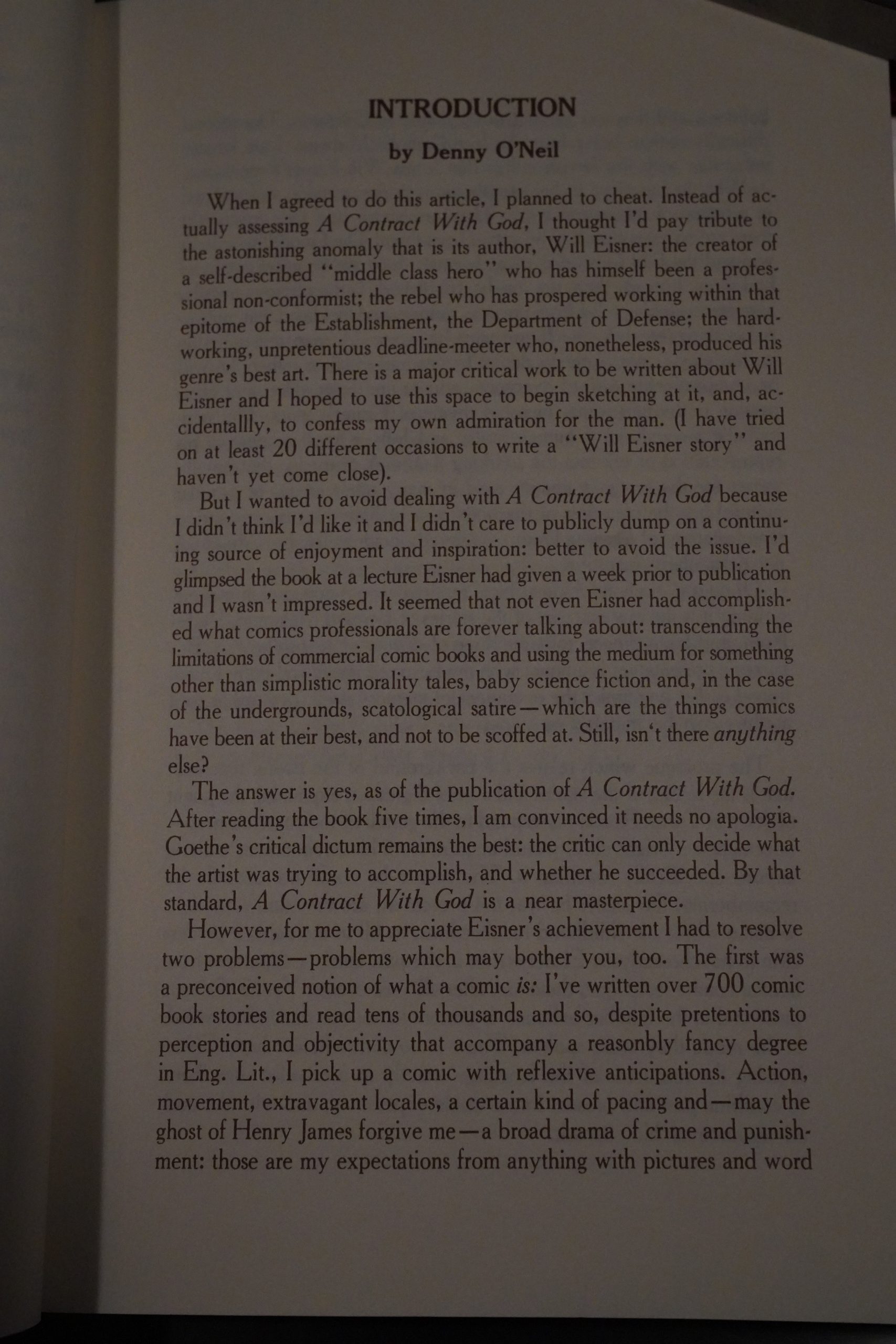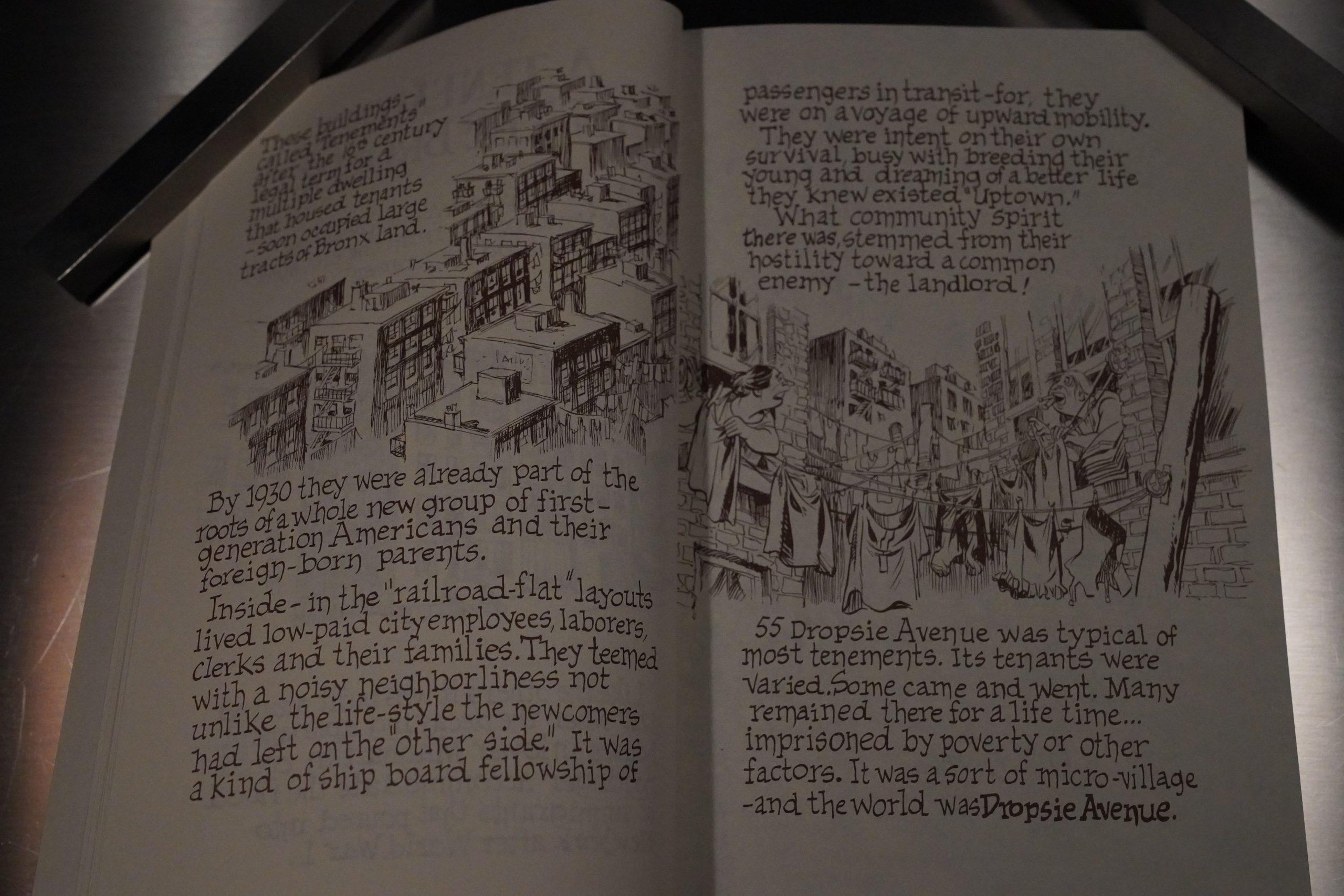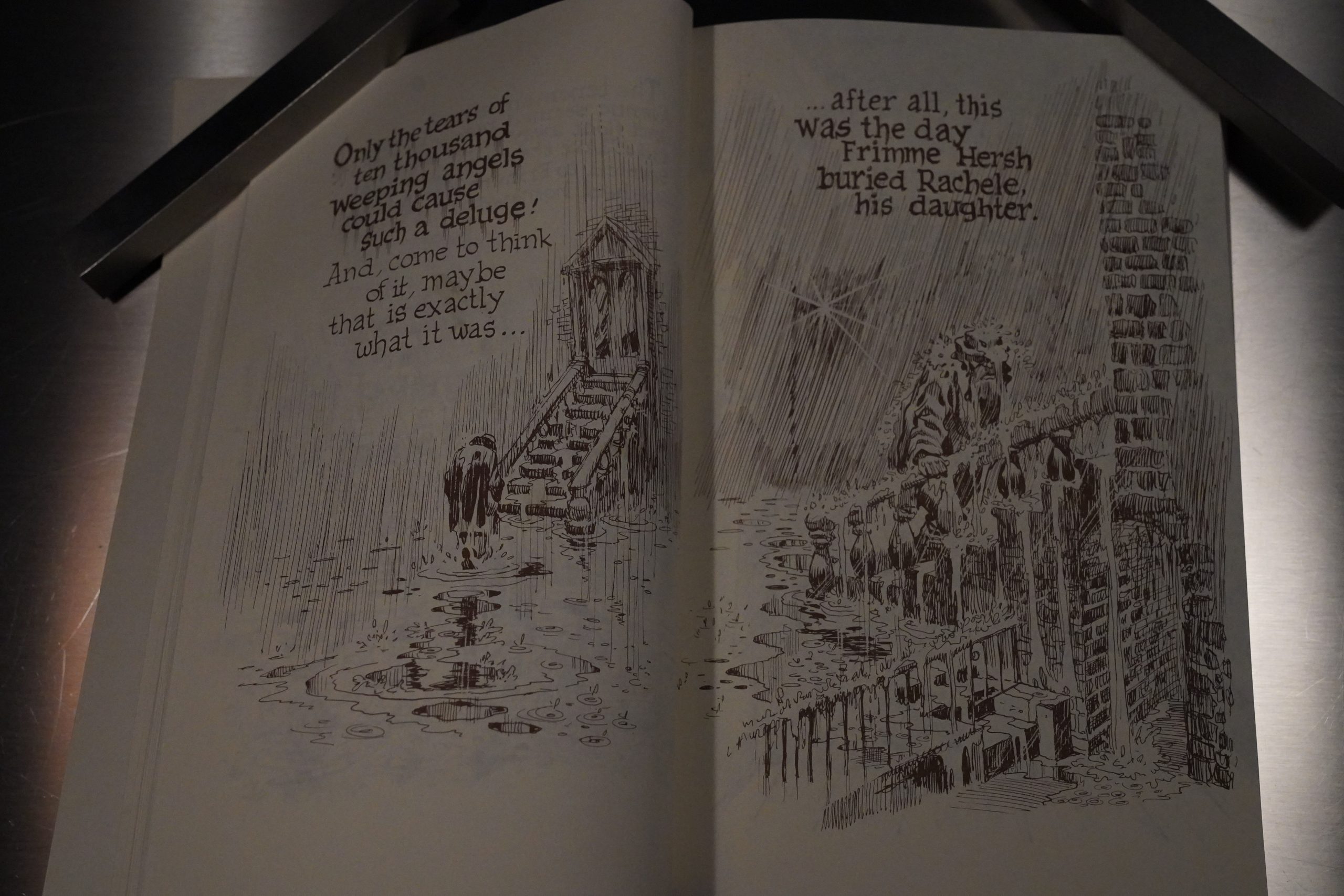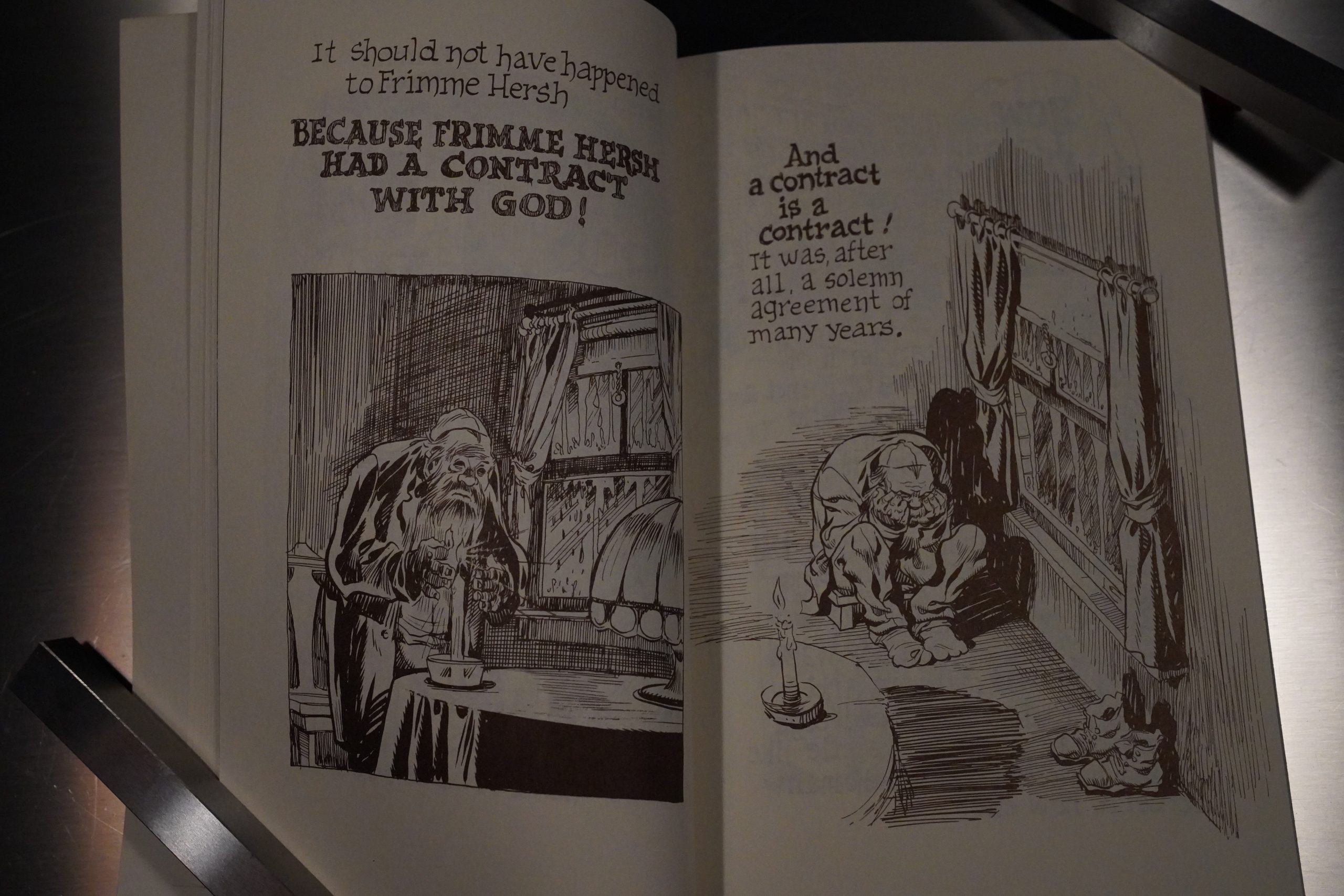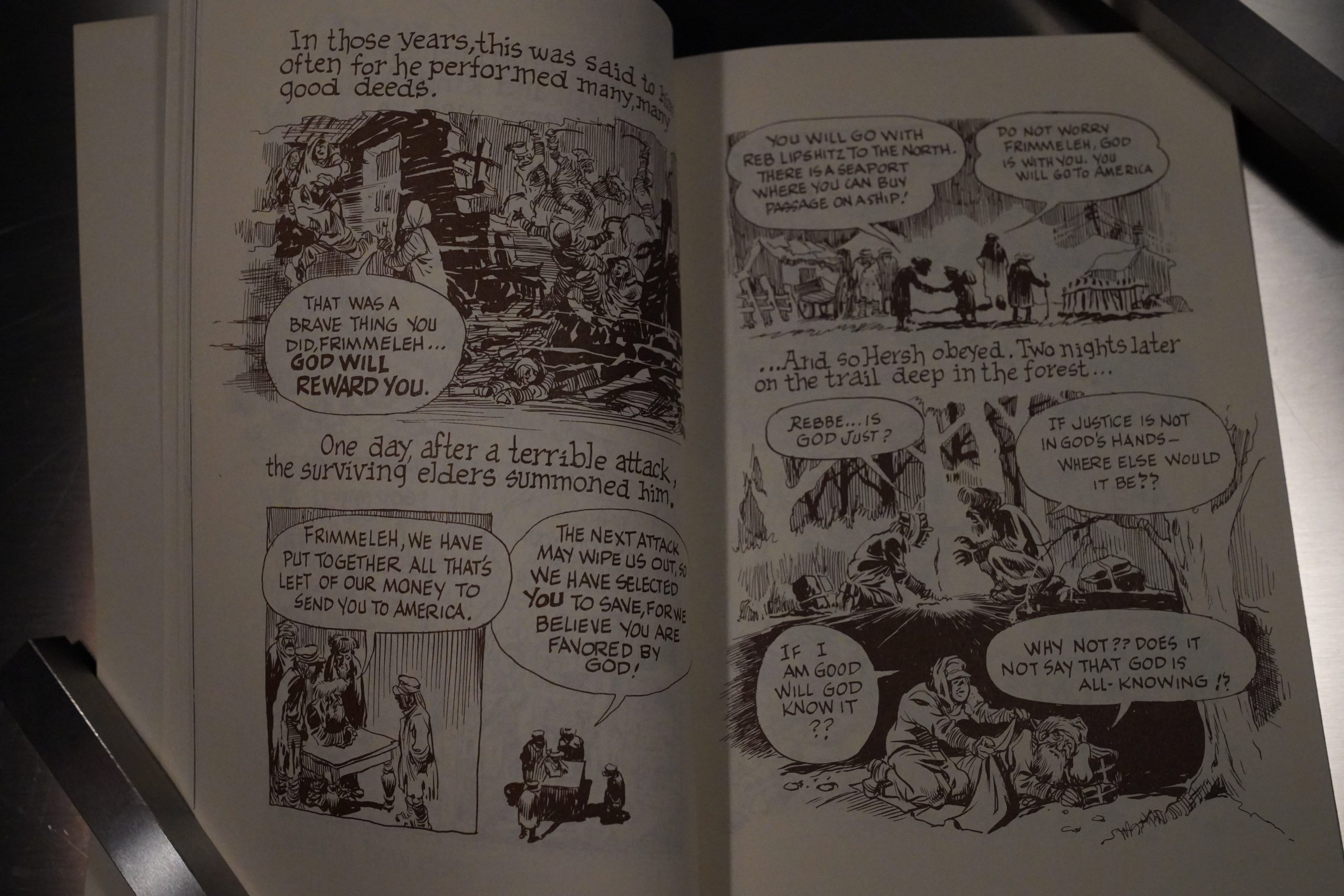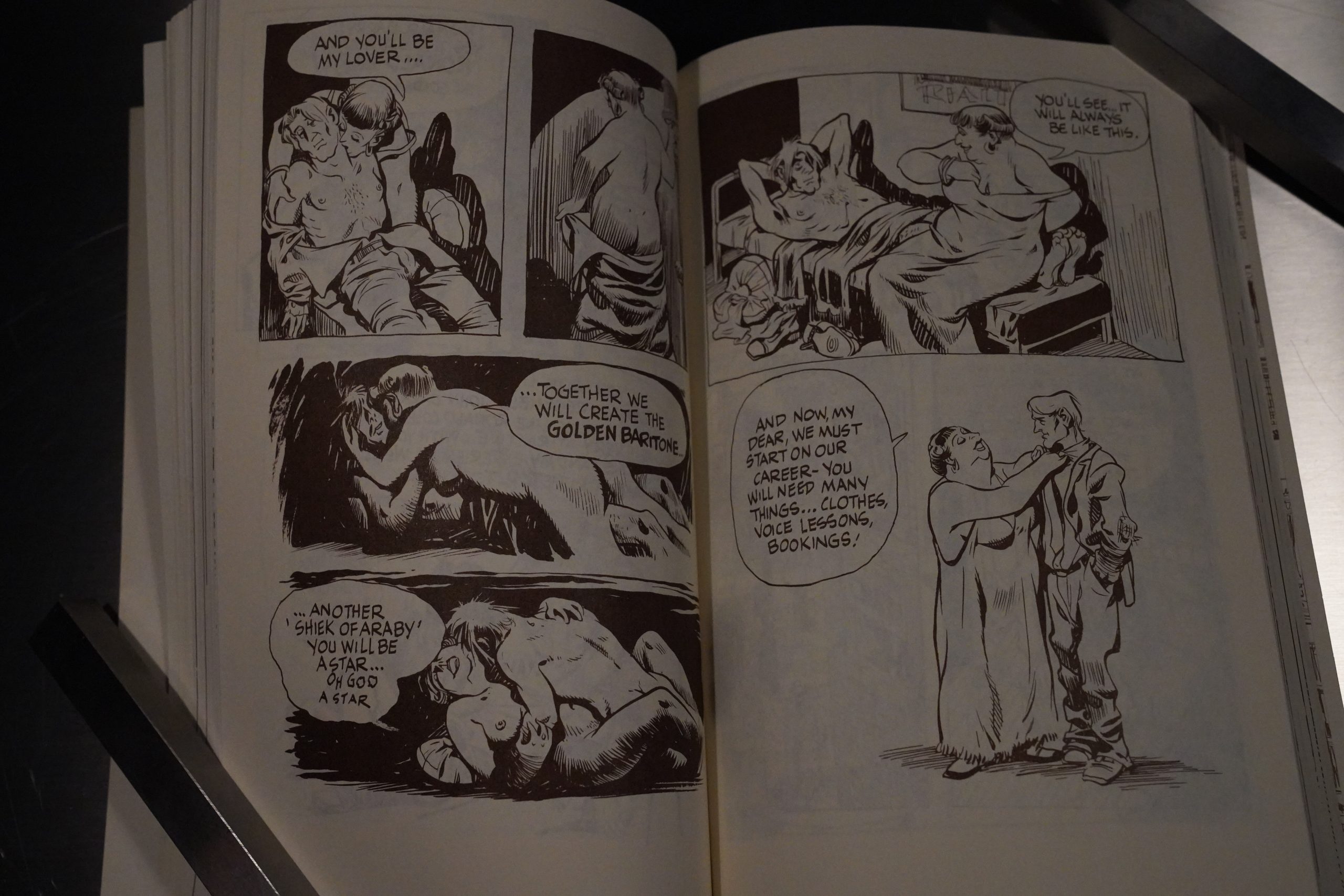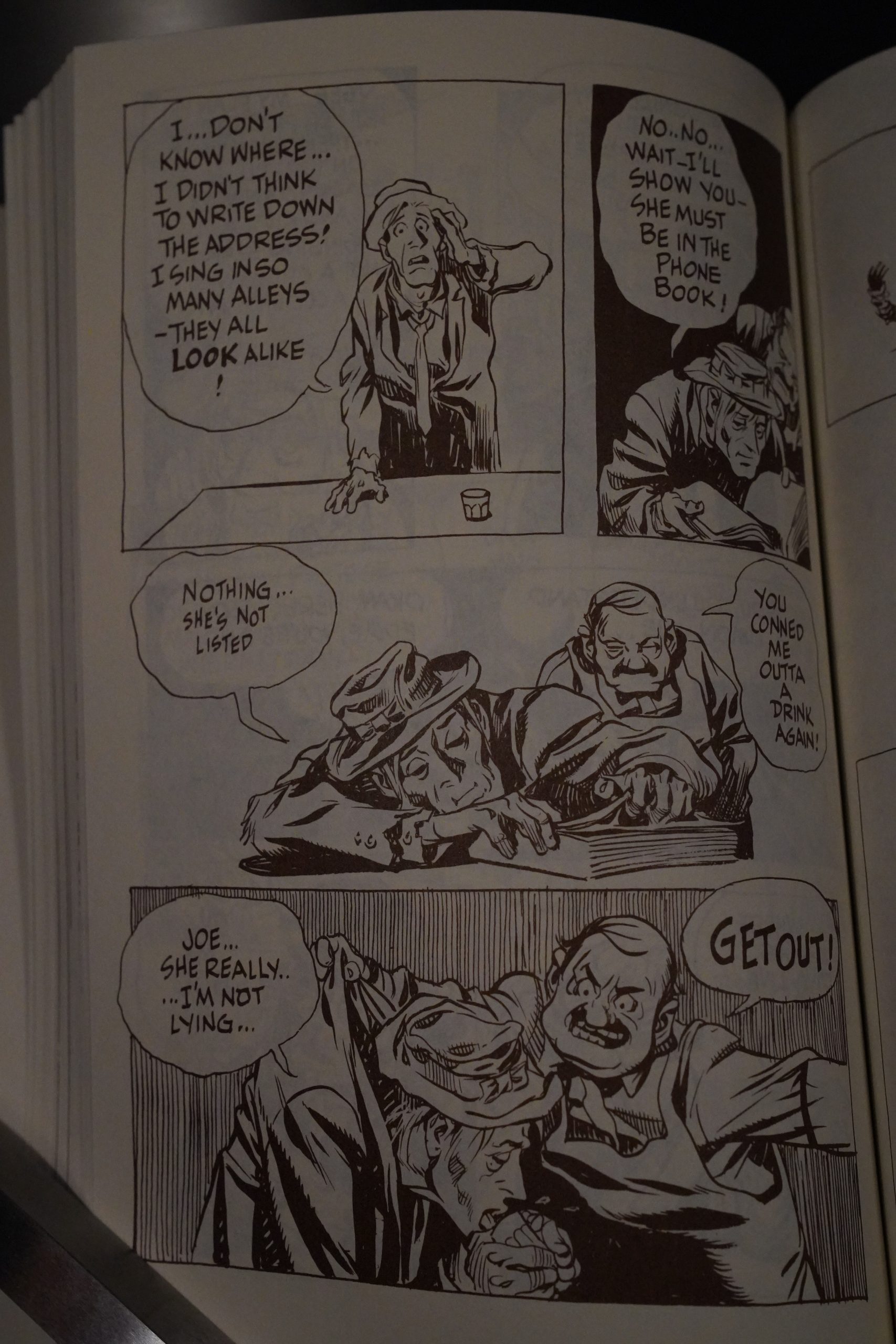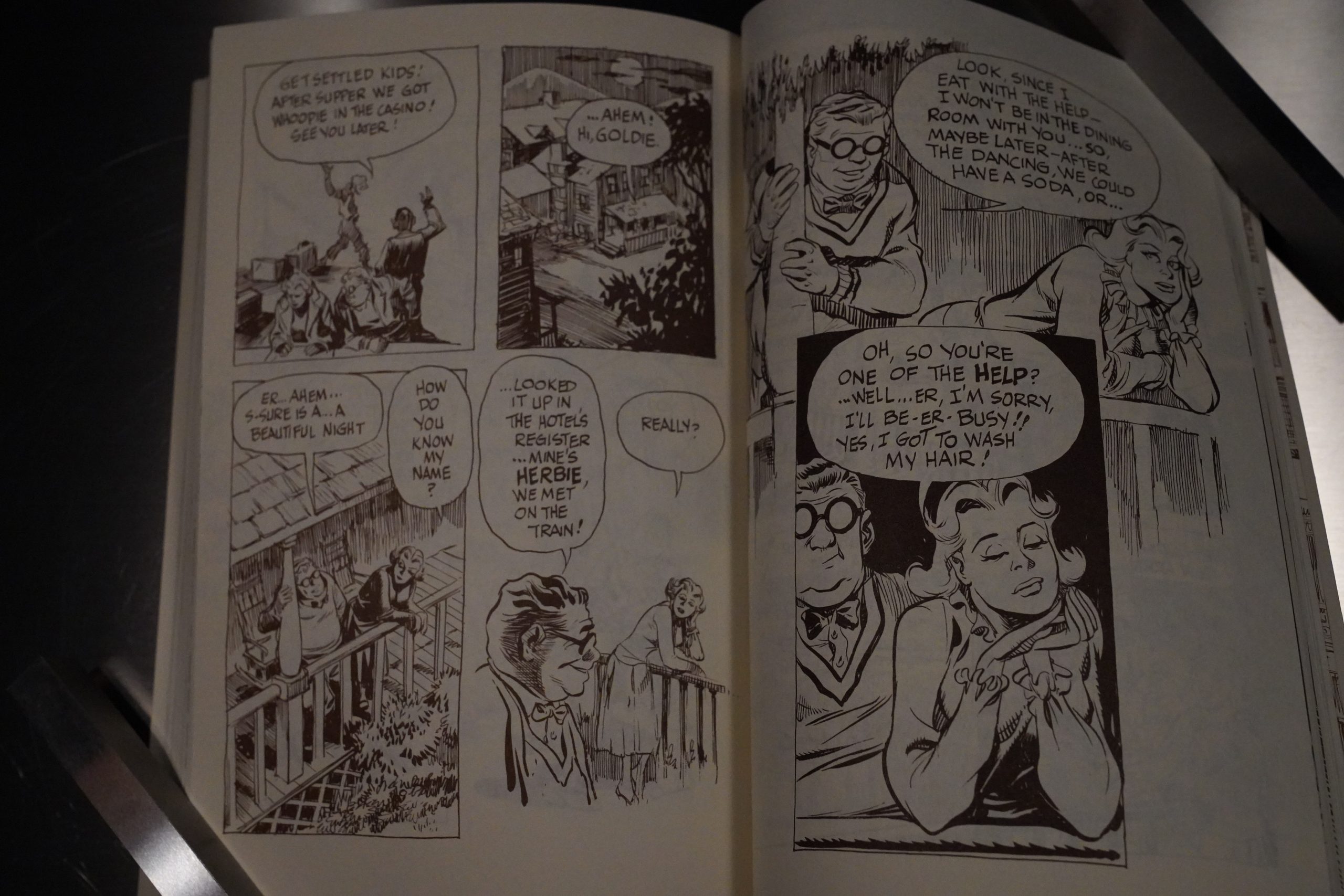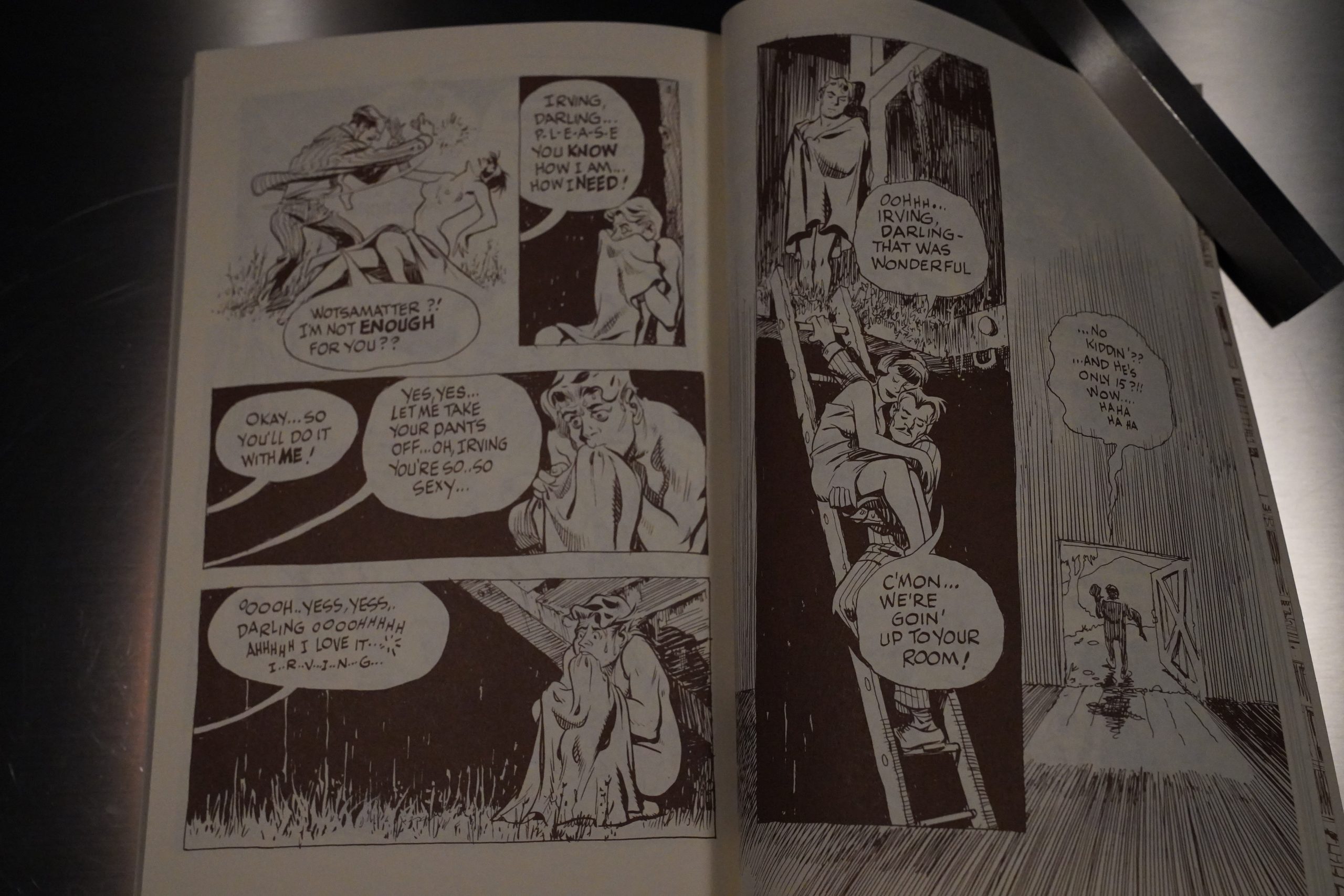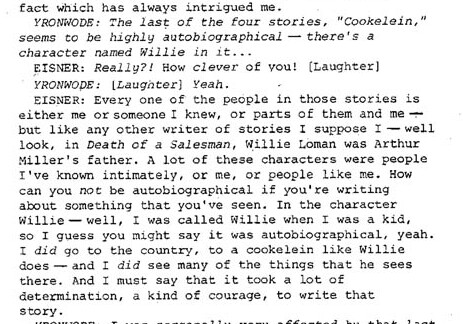A Contract with God (1985) by Will Eisner
This is a historically significant book, of course. After Kitchen Sink reprinted this in 1985, it hit the zeitgeist in a quite different way than when it was originally published in 1978. Soon afterwards, it was translated to basically all other languages, and was part of the wave of post-Maus-comics for adults looking for more stuff to read after the first Maus volume.
I bought this when it was published, and I was sixteen at the time. I don’t quite remember what I thought about the book — my copy here doesn’t seem to be well-thumbed, so perhaps I only read it once or twice?
I do remember A Contract With God being part of the conversation around comics, positioned as a kind of predecessor to Maus, showing that Maus wasn’t a singular freak of a book, but that it was, generally, possible to do intelligent comics. However, I don’t think the passing years have been kind to its legacy. First of all, Eisner would go around saying that it’s the first graphic novel, when there’d been several long (and serious) works in comics before the book, and besides, pendants would always point out that it’s a collection of short stories.
But the major reason is probably that the type of melodrama that Eisner dealt with was already three decades out of date by the time people became aware of the book.
We start with an introduction by Eisner where he pleads with the reader a bit.
Then we get another introduction by super-hero comics writer Denny O’Neil telling us how great the book is, and how different (because… it’s not about super-heroes…).
And then another introduction by Eisner!
C’mon.
Finally onto the first story of the book — about a guy making a contract with god, and the pathos is at 11 from the get go.
Eisner was a canny business guy, so it’s difficult not to imagine him calculating what themes to put into his book. “Hm, a book for adults… gotta have some adulting themes… how about… one story about god and stuff. But with an O. Henry twist! Yeah! That’d do it! ☑️” That’s really unkind on my part, but probably accurate?
Yeah, I think I pretty much was rolling my eyes constantly while reading this as a snotty teenager, and I’m even more snotty now. (Should I see a nose doctor, do you think?)
The artwork’s nice, and printing it using sepia instead of black ink was probably a good idea. Was it originally this way in the first edition? (Which Kitchen wanted to publish back in 78, but Eisner refused, taking it to a Real Book Publisher (who, if I’m reading things correctly, bilked him out of money and didn’t promote the book at all).)
Then we get a really, really 40s kind of story, but with sex. ☑️
It’s got an O. Henry ending.
Then a story about a paedophile janitor and a little girl that gets him killed (she’s bad to the bone). I’m not sure that counts as O. Henry? But ☑️.
The last story is the one that doesn’t seem rote: This seems like it’s going to be about two gold diggers that end up with each other instead of their targets (O. Henry A Hoy), but then that doesn’t happen. Instead one of the diggers rapes the other, and they both end up with their rich targets. Double whammy O. Henry!
But there’s also an unusual amount of sex and violence here that goes unresolved — no twist ending; just trauma and sadness. And that bit is the only bit that feels true and modern, while the rest is a 70s take on 40s melodramatic plots.
Is this a good book? It’s an interesting artefact, but I can see why I haven’t re-read it in three decades.
Eisner is interviewed in The Comics Journal #267, page 133:
KAPLAN: NOW, What do you rhink is
specifically allowed something like Maus to be
published in the ’80s, Where you
have something that was as overtly Jewish pub –
lishea’ in previous decades
EISNER: well, was published as a book
actually after Contract With God. I couldn’t
find a publisher then. According to what Art
Spiegelman told me, he began Maus early
on When he was an underground cartoonist,
and he did a thing called Breakdowns, it had
to do with his mother’s suicide and so forth,
and it’s just a thing that kept with him. He
had a bunch of those stories around. I’m
telling you What Spiegelman has told me. so
I have no other verification other than that.
He said that the publisher that ultimately
published Maus saw the collection Of stories
he had on that subject, and said, “You know,
this might make a book, I would like to
publish it!” So he continued it —a matter
of fact, he came to see me during the last
couple years It took him four years to put
the book together. He did a massive amount
Of research and interviewing. He came down
here in Florida to interview an aunt Who was
here in Florida, he
stayed here overnight
and we talked about
it. so the atmosphere
was growing, What
was happening was
that an adult audi-
ence was beginning
to appear. The same
reasoning that I had
in doing Contract With
God. The exception is
that he selected a sub-
ject that had greater
resonance than my
Story.
KAPLAN: Do you really
think so?
EISNER: Oh, yeah!
The discussion Of
the Holocaust the
Holocaust is a more
immediate and very
powerful subject! I
was talking about
something far more
intellectual, such as
man’s relationship
with God, a totally
different kind Of thing. The subject itself,
didn’t have the weight of a story about the
Holocaust. Aside from the fact that Maus
was a brilliant piece Of work.
KAPLAN: What specifically prompted you to do
Contract With God, do rhat story?
EISNER: Well, I was looking for stories that
were purely adult, that was not “cowboy
and Indian,” that it was something an adult
audience would be interested in. It was an
adult subject, if you will. I guess I put it
poorly, but it’s essentially an adult subject,
and I decided liked the Story that we are
all universally interested in. From our child-
hood, I realized that we have been told that
ifwe’re good, God will reward us. so, we
have a contract With God. And regardless Of
what religion you’re in, the same contract ex-
ists. If you’re a Christian, you’re told that if
you don’t sin, you’ll ultimately go to heaven.
That’ll be your reward. The Muslims believe
the same kind Of thing, Jews believe the
same kind of thing. They all believe that
we will sit on the right hand side of God. I
thought this would be a subject to explore,
so I did.
Dale Luciano writes in The Comics Journal #105, page 48:
When Eisner created A Contract With
God during the late 1970s, he did so out Of
personal need. He had in mind no particu-
lar publisher, there was no apparent market
for such a work, and how in the hell do you
pitch a melancholy book which uses words
and pictures to tell a series Of stories about
life in a Bronx tenement during the 1930s
to a publisher anyway?
Eisner went ahead wifh the book, regard-
less of the dim commercial possibilities.
Why?
Because he’d reached point in his life,
after all the years of churning out educa-
tional material for various clients (including
the Department of Defense), at which he
wanted to do something for himself.
Because he was an artist Who passionate-
ly wanted to make special use of his
medium, a form whose potential and POS-
sibility, he felt, had never been fully
explored.
Because he was a human being who
wanted to share With his audience a kalei-
doscope of recollection and reminiscences
from his youth.
And so he created A Contract With God,
in Which the portraits Of people and life we
see in and around the shabby, overcrowd-
ed Bronx tenement at 55 Dropsie Avenue
tell us something about what it felt like to
live in that particular time and place.
I had intentionally not re-read A Contract
With God since it originally appeared
because I’d been so moved by it. A work
of art which gives one considerable pleasure
at a certain point in life can appear “stale,
flat, and unprofitable” after the passage Of
a few intervening years. Unless stunted, one
gains something in knowledge, perspective,
taste, and (maybe) wisdom with age, and a
work which appeared audacious and
insightful on first encounter can, on later
re-examination, seem a juvenile embarrass-
ment. Often a work of originality and dar-
ing is so Widely imitated and so quickly ab-
sorbed into tradition that its impact when
first unveiled endures as nothing more than
a historical memory. (The work itself has
not changed; our individual and collective
attitudes toward it have.) In other cases,
especially in a field as hostile to innovation
and rethinking as the comic-book industry,
prevailing notions of what constitutes ori-
ginality and imagination are particularly
suspect.
All of which is also a roundabout way Of
saying that, on rereading, Eisner’s A Con•
tract With God remains for me a work Of
considerable merit, an artist’s testament that
he passed this way, saw these things, and
wished to share them with others. NO super-
heroes, no gimmicks, no hype, no visual
shenanigans, no garbage—just the stuff Of
raw experience, recollected with the perspec-
tive Of age, transfigured and elevated into
the realm Of contemplation and feeling by
an artist of’ compassion and sensi-
tivity.
A work of art, no ifs, ands, or buts about
don’t to say very much about the
book itself. One Of its chief charms is its
simplicity, and [ don’t want to spoil the
pleasure Of some Journal reader
who hasn’t yet encountered this book may
experience.
But I’ll say this: A Contract With God is
a remarkably unsentimental recollection Of
life in that shabby, Overcrowded tenement.
Those were difficult, soul-breaking years for
millions Of people, and Eisner recreates cer-
tain incidents—like the,suicide Of a building
superintendent, or the encounter between
a penniless street singer , and an aging
woman—that convey the bitter, frustrated
desperation of people whoknow intuitive-
ly their shabby, unhappy lives aren’t ever
going to get any better.
The Story which gives the book its title
concerns the disappointment and despair
of Frimme Hersh, a man who makes a “con-
tract With God” early in life. In return for
his many good deeds, God Will reward him
with justice. A decent man who has devoted
his life to good deeds, he is transformed by
the death Of his adopted daughter into a
withdrawn, embittered, solitary figure for
whom life offers no consolation. Late in his
life, he seeks a new “contract with
beginning—but it is too late.. .too
late…’
Hersh isn’t atragiC figure. He have
the kind of stature that makes for a tragic
figure. He’s a lost, pathetic, remote human
being, but Eisner somehow transforms his
story into a fable that evokes a sense of the
cruel, crushing, unforgiving fate that some.
times awaits us. We grieve for Frimme Hersh
because.. .life gets the best of him. And it
might do the same damn thing to us.
A Contract With God might have been just
a downer if it weren’t for the glimmerings
of hope and optimism that take on a special
poignance in view Of the more pathetic
passages. Most emphatically in “Cookalein,”
the hopefulness of youth—the yearning that
one’s lot in life be better and happier than
that Of loveless parents going grimly through
the motions of living—is embodied in the
figure of shy, Willie. ‘ ‘Willie” is
unmistakably Eisner’s self-portrait, and it’s
a tribute to his skill and discretion as a
storytellg_that Willie’s presence is anything
buf a maudlin or embarrassing presence.
Enough.
Eisner is one of the medium’s great story
tellers, and in A Contract With God, he
draws on life as his subject matter. His con-
siderable technique is placed in absolute ser-
vice of the story he’s telling, and there’s
never a moment when you feel he’s reaching
for an effect or hyping the material. In terms
Of the relationship between form and cone
tent, it’s a perfectly and exquisitely balanced
work.
Bill Sherman writes in The Comics Journal #267, page 94:
RETURN TO DROPSIE AVENUE
BY BILL SHERMAN
Reading the obituary of Will Eisner in
Time magazine, I caught a reference
to his status as an early grandmaster of the
graphic-novel format. In it, Eisner’s 1978
story collection, A Contract with God,
described as a novel about a Depression-era
slumlord. Studying that sentence, I imme-
diately felt the irritation most admirers Of
an artist’s work feel when the news media
gets the details wrong. Contract (which is
subtitled: And Other Tenement Stories) is
actually a collection of four stories, only the
first of which concerns a slumlord. Damn
it, I thought, is a graphic artist like Eisner
considered so trivial that they can’t even
fact-check his one-paragraph Obit?
That gaffe inspired me to pull the
book off the shelf, though, so I won’t grouse
too strongly. For all its stature as an early
graphic novel (we’ll pass over the non-issue
of whether Eisner “invented” the graphic
novel, since the artist himself references
Lynd Ward’s earlier woodcut graphic Sto-
ries in his intro), Contract had long seemed
rather musty to me, one of those works more
known for its quaint historical significance
than its capacity to entertain. Revisiting it,
I thought, would be like viewing a silent
melodrama: not bad for its place in the
development Of the medium but ultimately
out-of-step with our current “higher” stan-
dards of graphic storytelling.
That somewhat condescending at-
titude was happily knocked aside by my
rereading the actual book: a testimony to the
power of strong fiction to pull us out of our
preconceptions. Set in the Bronx during the
Great Depression, Contract tells a quartet Of
short stories about centering on the tenants
of 55 Dropsie Avenue, a setting Eisner would
return to with varying degrees of success in
books like A Life Force and The Neighbor-
hood. The protagonists of these stories are a
hardscrabble lot, many of them first genera-
tion immigrants stuck in a city that they
hoped would give them more. Eisner views
them With the unsparing unsentimentality[…]
In a recent eulogizing appreciation
of Eisner by Vertigo editor Karen Berger,
a comparison was made between the
writer-artist’s later books and Isaac Bashevis
Singer’s city-based works. But an equally apt
comparison can be made to O. Henry’s tales
of (the phrase has a totally different con-
notation than it did When William Sydney
Porter first used it, but never mind) “Bagh-
dad on the Subway.” The book’s two middle
stories come closest to approaching both O.
Henry’s style and the visual look of the old
Spirit stories — “The Super” even opens
with a splash page ironically echoing Eisner’s
classic Sunday series, while “The Street
Singer” caps its comeuppance ofa thorough-
ly unpleasant drunk and wife batterer with
a nicely set-up twist that O. Henry would
have surely recognized.
Eisner’s debt to a writer many serious
critics dismiss these days as contrived and
sentimental doesn’t help those of us attempt-
ing to stake a case for his larger artistry.
But, again, the artist’s sure visualizations of
his people are what really take A Contract
with God to a higher level: the moment
when aging would-be diva Marta Maria in
“The Street Singer” eagerly primps for street
singer Eddie is both comic and pathetic;
the scene where Germanic building super
Scuggs silently retreats to his basement to
both feed his dog and then masturbate is
still startling coming from Eisner; as is the
moment in “Cookalein” when wife Fan-
nie grimly rebuffs her cheating husband by
showing off her “ugly body.” Away from the
pulp world of Denny Colt, Eisner’s char-
acters proved to be deeper, sadder and ulti-
mately more interesting. It’s this simple step
forward in comic storytelling that makes
Contract and — Eisner’s other early graphic
novels — both groundbreaking and contem-
porarily vital. •
It’s #57 on the Top 100 Best Comics in The Comics Journal #210, page 59:
Will Eisner’s breakout book A Con-
tract With God and Other Tenement
Stories has a contentious claim to be
considered the first graphic novel.
This makes it important as a histori-
Cal curiosity, but hardly accounts
for its inclusion in this list. Much
more importantly, it marks a master
craftsman’s first attempt to turn the
comics medium from genre-based
storytelling to straight, literate fic—
tion. As great as all those old Spirit
stories are, Contrad is Eisner show-
ing us comics can be art and
self-expression as well as entertain-
ment.[…]
Striking a precarious balance of
urbanity and malevolence, Addams
sympathy for a grouchy, porn-ad-
dicted building manager who lusts
after a young tenant. Eisner is not
interested in heroes and villains,
and the characteristics which would
make the man repugnant in most
stories are coupled with vulner-
ability and humanity. In the final
story, “Cookalein, Eisner
casts his sympathetic eye
for human foibles on a
group of urban residents
summering in the country
who grope about in
clumsy searches for love,
sex and social advance-
ment.
The specificity Of set—
ting lends authenticity to
the universality Of
Eisner’s concerns, which
include love, loss, alien-
ation, hope and despair.
Eisner’s formal creativity
and mastery of atmo-
sphere invest these tales
with emotional power.
The novelty of the format
aside, A Contract With God
is a moving and compelling
book, and the masterpiece
ofone ofthe medium’s first
true artists.
Huh! The one bit I found convincing in the book — the Willie bits — was autobiographical? Huh!
This is a very good summary of the history of the book:
Revisionist history may credit Eisner as a pioneer in the graphic novel field, and Eisner’s shadow still looms so large over the entire medium of comic books that it seems impossible that his work in 1978 wouldn’t have been a gauntlet thrown down to the industry. But it wasn’t Eisner’s A Contract With God that broke through the bookstore barrier. It was just a weird, largely ignored picture book when it was released; one that might have been appreciated by a certain portion of the readership, like the comic book aficionados who had been catching up with black-and-white Spirit reprints and were curious to see what Eisner was up to at the age of 61.
[…]
I don’t know that A Contract with God is hailed as a masterpiece anymore. A landmark, maybe. Masterpiece? Not so much.
This is the seventy-third post in the Entire Kitchen Sink blog series.
